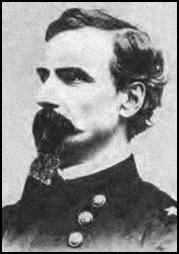John Wynn Davidson was born at Fairfax County, Virginia, August 18, 1824. His Grandfather had been a General in the Revolution and his Father, who graduated from the United States Military Academy in 1815, died in the service 25 years after his graduation.
Davidson graduated from the United States Military Academy in 1845 and, after frontier duty in Kansas and Wisconsin, took part in the Mexican War, mainly in California with the so-called Army of the West. He was promoted to Captain, 1st United States Dragoons in 1855, and fought Indians throughout New Mexico and California, and was wounded in an engagement with Jirarilla Apaches.
At the start of the Civil War he was stationed at Fort Tejon near Los Angeles, and it is alleged that declined commission in the Confederate Army. After duty in the Washington, D.C. defenses, he was appointed a Brigadier General of Volunteers to rank from February 3, 1862, perhaps as a reward for adherence to the Union, and commanded credibly a brigade of W. F. Smith’s Division of Keyes’s IV Corps in the Peninsular Campaign. Late in the summer of 1862, he was assigned to the command of the District of St Louis, his wife’s hometown.
The rest of his Civil War career was spent in Missouri and Arkansas, where was Commander of the Army of Southwest Missouri in 1863 and the Army of Arkansas in 1864 and Chief of Cavalry of the Deptartment of West Mississippi in 1865. In the meantime, he was breveted through all grades to that of Major General in both the Regular Army and the Volunteer Service.
After the Civil War he was in the Inspector General’s Department for a time and from 1868 until 1871 was professor of military science-tactics at the Kansas Agricultural College. After holding various commands in Texas and Indian Territory, he was promoted to Colonel of the 2nd United States Cavalry in 1879. Two years later, while on duty at Fort Custer, Montana, he was badly injured when his horse fell with him.
He died while on sick leave at St Paul, Minnesota, June 26, 1881. He was subsequently buried with full military honors in Section 2 of Arlington National Cemetery.
In 1866 Davidson was commissioned Lieutenant Colonel of the Tenth United States Cavalry. Since the regiment consisted of black Buffalo Soldiers, he soon acquired the nickname “Black Jack.”
With the outbreak of the Red River War,qv Davidson, on September 10, 1874, led six companies of the Tenth Cavalry, three of the Eleventh Infantry, a section of mountain howitzers, Lieutenant Richard H. Pratt’s Indian scouts, and forty-six supply wagons out of Fort Sill into the Texas Panhandle in search of Indians. Marching north to the Washita River, Davidson then turned west and for over a week toiled along the breaks of the Red River tributaries. By October fifty-eight horses and mules had been lost, and forage and rations were running low. Davidson’s men surprised a band of Kiowas on October 2, but the remaining animals were too worn to carry out pursuit successfully. On October 24 he received the surrender of a Comanche band his troops had defeated on Elk Creek. With the onset of northers, sleet and snow in mid-November, about twenty-four troopers suffered from severe frostbite, food and supplies ran low, and 100 animals died during the “Wrinkled-hand Chase.” However, Davidson and his subordinates destroyed several Indian camps and captured nearly 400 Indians and over 2,000 of their horses before returning to Fort Sill on November 9. In March 1875 Davidson relinquished regimental command to Benjamin H. Grierson and was transferred to Fort Griffin in Shackelford County, Texas, where his duties were confined mainly to patrolling the nearby cattle trails and cow camps. In December 1876 Davidson became commander at Fort Richardson until its abandonment in 1878, then once more at Fort Sill. In January 1879 he was sent to command the garrison at Fort Elliott. There his humane policy toward transient Indians from the reservations brought him into sharp conflict with the Texas Ranger Captain, George W. Arrington.
Promoted to colonel of the Second Cavalry on June 25, Davidson took command of that regiment at Fort Custer, Montana. On February 8, 1881, Davidson was seriously injured during an inspection tour when his horse slipped on ice and fell on top of him. He died at St. Paul, Minnesota, on June 26, 1881. He was buried in the Bellefontaine Cemetery in St. Louis, and his remains were reinterred in Arlington National Cemetery in 1911.
DAVIDSON, JOHN W
- COL BRIG CEN 2ND US CAV VOLS
- DATE OF DEATH: 06/29/1881
- BURIED AT: SECTION 2 SITE LOT 1199
ARLINGTON NATIONAL CEMETERY
Michael Robert Patterson was born in Arlington and is the son of a former officer of the US Army. So it was no wonder that sooner or later his interests drew him to American history and especially to American military history. Many of his articles can be found on renowned portals like the New York Times, Washingtonpost or Wikipedia.
Reviewed by: Michael Howard

